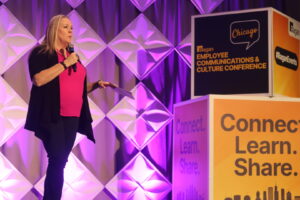How to rethink communicating company culture
Ping pong tables, unlimited access to beer on tap, and an office full of people wearing jeans and sneakers while lounging on bean bags. That’s the recipe for a thriving, modern company culture. Or is it?

Culture has little or nothing to do with what people wear, social events, and office perks. Culture is defined by how we work and how we treat each other. Here’s why.
- Compassion has nothing to do with office design
Companies spend a lot of time, energy, and resources dressing their offices and teams in superficial, supposedly fun, and inspiring coating – casual outfits, lounge furniture, game rooms, social get-togethers, snacks – you name it. Great – perks are nice! But they can never replace transparency, inclusion, and compassion. Those values have nothing to do with interior design, but everything to do with how we show or don’t show compassion towards our colleagues, especially if we are managers or have other leading positions. Watch your behavior – it sets the tone.
- The way we work is at the core of our culture
The way we work is not ‘also culture’ – it is the central component of corporate culture. By setting certain standards and routines for how, when, and why we collaborate (or not), we contribute to how a company culture evolves.
Do you schedule meetings at lunchtime or expect attendance at events outside regular working hours? That demonstrates lack of respect for people’s time.
Do you consider parents’ childcare obligations when planning dates and times for important meetings? That’s essential to being inclusive to employees with children.
Do you expect people to be online and available at all times just because technology enables it? That shows a lack of boundaries.
Do you trust your employees to do their job or do you constantly supervise? The latter is micromanaging. The list goes on.
- You can’t ‘create a culture’ – only set the stage for it
Like any other type of culture, work culture is an organic, dynamic, and living thing. It’s not fixed and static. Hence it’s not possible to ‘create’ and expect it to be done and implemented once and for all. It will forever be dependent on the people who carry it – leaders and employees of the organization.
However, it’s essential to set the stage for the culture that you wish to have and maintain. This includes designing policies, routines, and habits that create the conditions and support the behaviors you want the culture to consist of. That way, the ‘right’ culture can emerge and thrive.
All in all, culture is defined by how we treat each other daily. How we speak to and about each other, how we respect -(or not!) each others’ time, how we trust (or not!) each other, how we collaborate, how we lead – and how we follow.
THAT’s culture. Anything else is just superficial make-up or, at best, icing on the cake.
Malin H. Teles is the communications manager at EGGS Design, a design-driven innovations consultancy based in Scandinavia.






